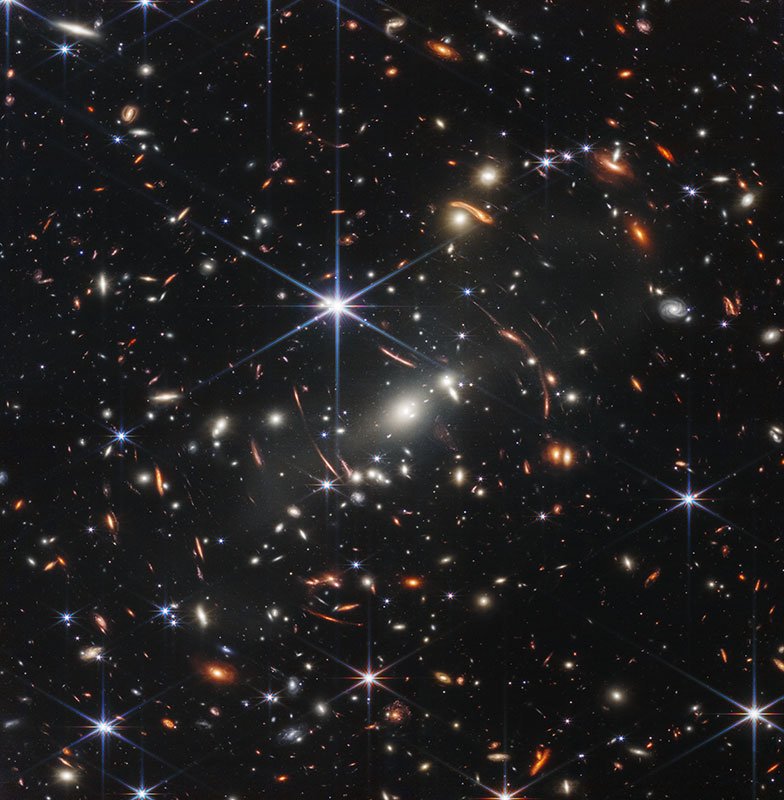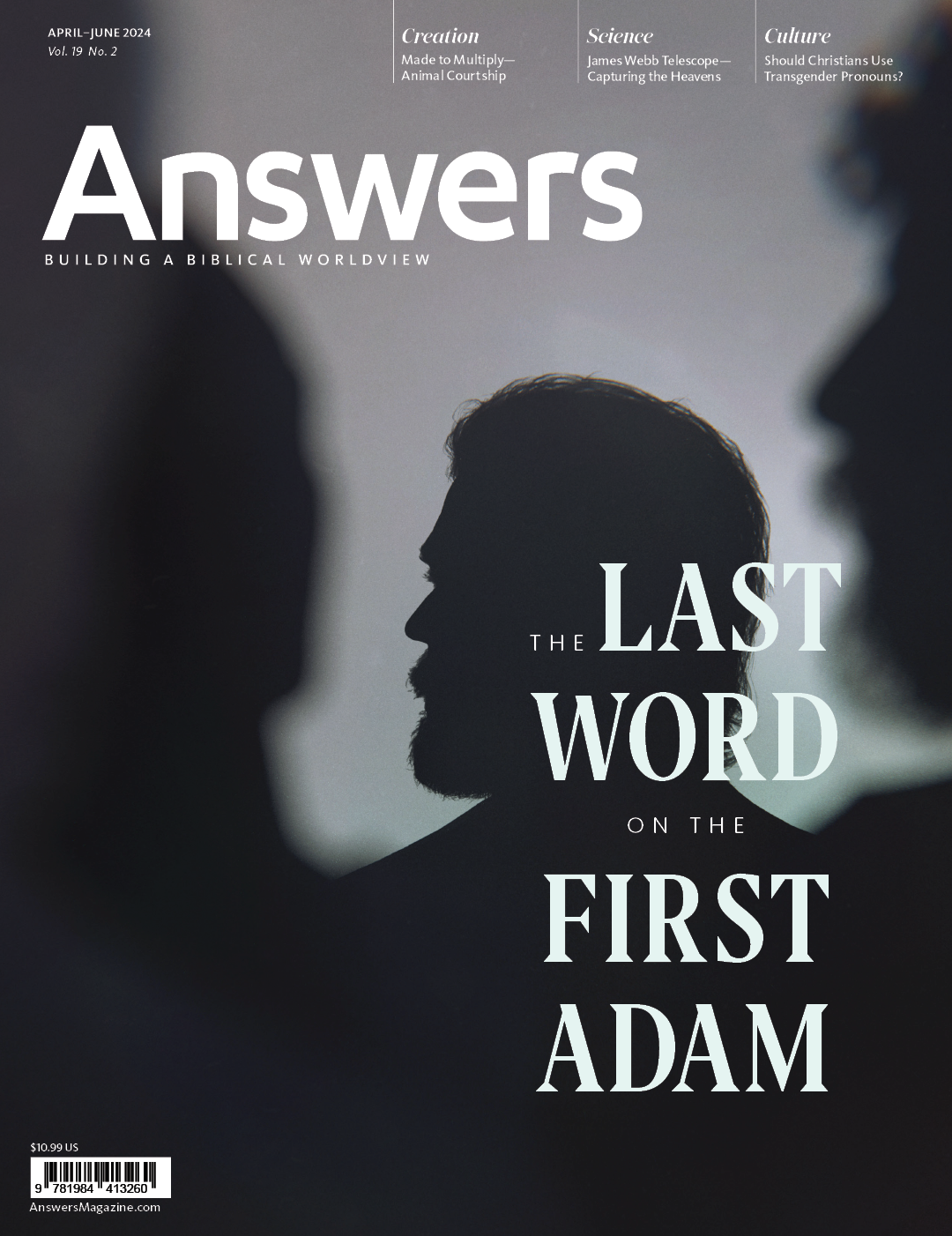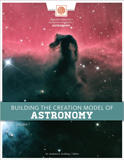
What Does the James Webb Space Telescope Show Us?
A Better View
Since becoming fully operational in 2022, the James Webb Space Telescope (JWST) has been collecting some of the most breathtaking images of the heavens ever seen. Roughly the size of a tennis court, this $10-billion observatory is the largest and most powerful telescope ever built.
The deep field image of a galaxy cluster, called SMACS 0723, is just one example that displays the glory of our God (Psalm 19:1). This is by far one of the most intriguing clusters, showing many “mature” galaxies at distances much farther than secular scientists predicted.
Observations from space telescopes like JWST do not show us how or when stars and galaxies formed. Rather, these observations simply tell us what they look like. The interpretation of these images is driven by a scientist’s worldview. Everyone has a worldview built on only one of two options: God’s Word or man’s word. Our worldview largely influences our scientific predictions.
It’s an important characteristic of a good scientific model to make correct, specific predictions. The incredible findings from the JWST have made shockwaves in the secular astronomy community—causing secular scientists to totally rethink their models. Meanwhile, these findings have been consistent with predictions made by biblical creationists, which is no surprise because we have the advantage of building our models on the infallible Word of God. Looking at the predictions and the worldview behind them allows us to see how a biblical creation worldview better explains the evidence we’re seeing in the far-flung recesses of our universe.
What Did Secular Scientists Predict the JWST Would Find?
Most secularists in the science community believe in naturalism, explaining the existence of the universe only by natural laws, absent of supernatural intervention. In their naturalistic origin story called the big bang, the universe began around 13.8 billion years ago when space and energy appeared in a very hot, dense state before gradually cooling and expanding into the universe we see today.
When secular scientists are studying images taken by the JWST, they’re interpreting the data through their naturalistic worldview. They believe the first stars (called population III stars) formed around 300 million years after the big bang, corresponding to a redshift of about 14. In general, the farther the distance of a galaxy, the more its visible light is shifted into the infrared (redshifted). In other words, the farther the distance, the higher the redshift value.
As the story goes, those stars were then gravitationally attracted to form the first galaxies and gradually matured into large spiral-shaped or elliptical-shaped galaxies.
Secularists also believe population III stars contained only hydrogen, helium, and a little bit of lithium. Therefore, no elements heavier than lithium should exist in the earliest stars. As their story goes, these population III stars eventually got large enough to fuse lighter elements in their cores, producing heavier elements (such as carbon and oxygen). And when these stars exploded, the heavier elements spread out into space, allowing the next generation (population II) stars to contain some amount of these heavier elements.
Secular scientists also believe that the light from the most distant galaxies takes billions of years to reach us on the earth. Consequently, they claim to be seeing the formation of the first galaxies from billions of years ago.1
Based on their naturalistic beliefs, secular scientists had three main predictions for what the JWST would find:
- No galaxies with a redshift value higher than roughly 14 (beginning around 300 million years after the big bang) and to find relatively few galaxies approaching that distance.
- The earliest stars in the process of forming and assembling into unstructured galaxies (irregularly shaped with very low mass).
- A steady decrease in heavy elements with increasing redshift, and the most distant (earliest) stars being population III stars (containing no elements heavier than lithium).

Photo by NASA, ESA, CSA, STScI
This JWST image of the galaxy cluster SMACS 0723 covers a piece of the sky the size of a grain of sand held at arm’s length by a person standing on earth.
What Did Biblical Creationists Predict the JWST Would Find?
Rather than relying on fallacious assumptions about the past, it’s always better to start with a historical, eyewitness account. And the Bible is that account—the true history book of the universe beginning in Genesis. When we start our thinking with God’s Word, we know stars (and galaxies) were supernaturally created by our almighty God on day four of creation week, around 6,000 years ago (Genesis 1:14–19).2 That is, stars and galaxies did not form gradually over billions of years—they were formed at God’s command when “he made the stars also.”
Starting with God’s Word, we also know that water existed on day one of creation week (Genesis 1:2)—before the stars were created—so heavy elements, like oxygen, have always been around. Thus, the universe did not start off with only hydrogen, helium, and lithium.
In January 2022—before any data were available from the JWST—Dr. Jason Lisle (Christian astrophysicist and founder of the Biblical Science Institute) successfully made the following three general predictions based on a biblical model—all nearly the direct opposite of the secular predictions:3
- Galaxies at higher redshifts than secularists were expecting, forcing them to conclude that galaxies formed earlier than their secular models had predicted.
- Massive symmetric galaxies that are fully formed—not in the process of assembly—like the spiral and elliptical galaxies found relatively close to us.
- Elements heavier than lithium in the most distant stars.

Photo by NASA GSFC/CIL/Adriana Manrique Gutierrez
An artist’s depiction of the James Webb Space Telescope.
What Did JWST Find?
JWST continues to find distant galaxies that have caused secular scientists to scratch their heads. So far, the telescope has spotted:
- Fully formed galaxies at extreme distances, with an abundance of galaxies at redshifts greater than 10, and even some possibly at redshifts as high as 20 (if so, this would translate to less than 180 million years after the big bang, per the secular timeline).
- Massive, highly structured (spiral and elliptical) galaxies with no evidence of gradual mass accumulation.
- Distant galaxies that are enriched with oxygen and other heavy elements.
To summarize, the galaxies that are far away look just like the ones that are close by—a paradox for naturalistic thinking. It’s as if these galaxies were spoken into existence by our powerful God—as described in his Word!
Biblical creationists are frequently accused of not having scientific models that can make accurate predictions. But based on these latest observations, secular scientists are being forced to revamp their galaxy formation models, now claiming that galaxies must have formed much earlier than previously thought—exactly the prediction Dr. Lisle made back in January 2022.
One Last Prediction
After the data from the JWST first started coming in, astronomer Allison Kirkpatrick said, “Right now I find myself lying awake at three in the morning wondering if everything I’ve ever done is wrong.”4 But will these baffled secular scientists truly reconsider their beliefs and worldview?
Dr. Lisle made another successful prediction back in January 2022:
I predict that the secular community (as a whole) will not be moved by these amazing results from the James Webb Space Telescope. Despite all evidence to the contrary, they will continue to believe in a big bang, and that stars and galaxies spontaneously formed over millions of years. They will simply push these stories to a much earlier time, so that they are beyond verification (or falsification) by our current technological limits. They will not give up the big bang or evolution—no matter what evidence is found. This confirms that the big bang is not really science at all, but a philosophical precommitment in light of which secularists interpret all data.
In other words, it’s not about the evidence—it’s about the interpretation of the evidence based on the worldview to which one is committed.
The Bible states that people would rather believe anything other than the truth because people love the darkness of sin rather than the light (Jeremiah 17:9–10; John 3:19–21; Romans 1:18–25). Ultimately, this should remind us to keep sharing the gospel message of Jesus Christ with every creature (Mark 16:15).
As we discuss the brilliant findings of the JWST, we can point people to the Creator, who not only spread out the heavens, but more importantly, sent his Son from heaven to take on human flesh, die on a cross for our sins, and rise from the grave.
Editor’s note: Originally published as “A Better View: James Webb Space Telescope”
Answers Magazine
April–June 2024
When we deny the existence of a literal Adam, we undermine the very authority of Scripture.
Browse Issue SubscribeFootnotes
- This is a common objection to the biblical timescale, called the “distant starlight problem” (i.e., how can stars be billions of light years away if God created them only 6,000 years ago). It’s beyond the scope of this article to fully explain the answer, but if you’d like to know more, start here: https://answersingenesis.org/astronomy/starlight.
- As a side note, I believe much of the confusion for people, regarding far distances to stars and galaxies, is the definition of a light-year, which is a unit of distance—not time! A light-year is simply the distance it takes light to travel in one year, which equates to about 6 trillion miles (9.7 trillion kilometers). And obviously, because the universe is so mind-bogglingly big, it doesn’t make sense to use units of miles or kilometers. To make things simpler, scientists measure astronomical distances in units of light-years.
- For a fuller discussion of these predictions, check out the live interview that Dr. Faulkner and I had with Dr. Lisle on Sep. 14, 2022, on YouTube: https://www.youtube.com/watch?v=6BZMtnLzu-8&ab_channel=CreationMuseum. I recommend going to the BSI website to get more details about Lisle’s predictions: https://biblicalscienceinstitute.com/astronomy/the-james-webb-space-telescope.
- “Four Revelations from the Webb telescope About Distant Galaxies,” Nature, July 27, 2022: https://www.nature.com/articles/d41586-022-02056-5.
- For more details on Dr. Lisle’s predictions, along with several examples of published articles that appropriately describe the secularists’ struggles with the JWST findings, you can read the full article here: https://biblicalscienceinstitute.com/origins/creation-cosmology-confirmed.
Recommended Resources

Answers in Genesis is an apologetics ministry, dedicated to helping Christians defend their faith and proclaim the good news of Jesus Christ.
- Customer Service 800.778.3390
- © 2024 Answers in Genesis






